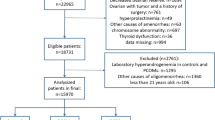Abstract
Diagnosis of polycystic ovary syndrome (PCOS) is very difficult in women with ovulatory cycles. We assessed the diagnostic value of prostate-specific antigen (PSA) and free prostate-specific antigen (fPSA) in women with ovulatory or anovulatory PCOS. Study group consisted of 62 women with PCOS and 35 healthy female controls. PCOS group was divided into two subgroups as anovulatory (n = 42; 68%, Group A) and ovulatory group (n = 20; 32%, Group B). A cut-off level of PSA and fPSA was established for the sensitivity, specificity, positive likelihood ratio, area under curve, diagnostic accuracy, and positive and negative predictive values of diagnosis of PCOS. In group A, a PSA level of greater than 10 pg/ml yielded a sensitivity of 73.2%, a specificity of 80%, and a diagnostic accuracy of 73%, with a positive predictive value of 88.2% and a negative predictive value of 59.3%. An fPSA level of greater than 2.1 pg/ml yielded a sensitivity of 71.2%, a specificity of 80.4%, and a diagnostic accuracy of 87%, with a positive predictive value of 87.2% and a negative predictive value of 58.4%. In group B, a PSA level of greater than 10 pg/ml yielded a sensitivity of 65%, a specificity of 80%, and a diagnostic accuracy of 73%, with a positive predictive value of 76.5% and a negative predictive value of 69.6%. An fPSA level of greater than 2.1 pg/ml yielded a sensitivity of 65.4%, a specificity of 80.4%, and a diagnostic accuracy of 87%, with a positive predictive value of 75.5% and a negative predictive value of 68.4%. Circulating androgens and hirsutism are independently associated with the degrees of PSA and fPSA in PCOS women. Increased plasma levels of PSA (>10 pg/ml) and fPSA (>2.1 pg/ml) could be helpful as a diagnostic tool for women with ovulatory or anovulatory PCOS.



Similar content being viewed by others
References
J.S. Laven, B. Imani, M.J. Eijkemans, B.C. Fauser, Obstet.Gynecol.Surv 57, 755–767 (2003)
J. Adams, D.W. Polson, S. Franks, Br.Med.J.(Clin.Res.Ed) 293, 355–359 (1986)
E. Carmina, R.A. Lobo, Am.J.Med 111, 602–606 (2001)
S. Franks, Clin.Endocrinol.(Oxf) 31, 87–120 (1989)
M. Asuncion, R.M. Calvo, J.L. San Millan, J. Sancho, S. Avila, H.F. Escobar-Morreale, J.Clin.Endocrinol.Metab 85, 2434–2438 (2000)
A.H. Balen, G.S. Conway, G. Kaltsas, K. Techatrasak, P.J. Manning, C. West, H.S. Jacobs, Hum.Reprod 10, 2107–2111 (1995)
E.S. Knochenhauer, T.J. Key, M. Kahsar-Miller, W. Waggoner, L.R. Boots, R. Azziz, J.Clin.Endocrinol.Metab 83, 3078–3082 (1998)
M. Pugeat, M.H. Nicolas, J.C. Craves, C. varado-Dubost, S. Fimbel, H. Dechaud, H. Lejeune, Ann.N.Y.Acad.Sci 687, 124–135 (1993)
A. Vermeulen, L. Verdonck, J.M. Kaufman, J.Clin.Endocrinol.Metab 84, 3666–3672 (1999)
D. Cibula, M. Hill, L. Starka, Eur.J.Endocrinol 143, 405–408 (2000)
R.T. McCormack, H.G. Rittenhouse, J.A. Finlay, R.L. Sokoloff, T.J. Wang, R.L. Wolfert, H. Lilja, J.E. Oesterling, Urology 45, 729–744 (1995)
M.C. Wang, L.A. Valenzuela, G.P. Murphy, T.M. Chu, Invest Urol 17, 159–163 (1979)
E.P. Diamandis, H. Yu, J.Clin.Endocrinol.Metab 80, 1515–1517 (1995)
H. Yu, E.P. Diamandis, D.J. Sutherland, Clin.Biochem 27, 75–79 (1994)
D.N. Melegos, H. Yu, M. Ashok, C. Wang, F. Stanczyk, E.P. Diamandis, J.Clin.Endocrinol.Metab 82, 777–780 (1997)
H. Yu, H. Berkel, J.La State Med.Soc 151, 209–213 (1999)
S. Gullu, R. Emral, M. Asik, M. Cesur, V. Tonyukuk, J.Endocrinol.Invest 26, 1198–1202 (2003)
C. Negri, F. Tosi, R. Dorizzi, A. Fortunato, G.G. Spiazzi, M. Muggeo, R. Castello, P. Moghetti, J.Clin.Endocrinol.Metab 85, 81–84 (2000)
C.V. Obiezu, A. Scorilas, A. Magklara, M.H. Thornton, C.Y. Wang, F.Z. Stanczyk, E.P. Diamandis, J.Clin.Endocrinol.Metab 86, 1558–1561 (2001)
D. Ferrıman, J.D. Gallwey, J.Clin.Endocrinol.Metab 1961(21), 1440–1447 (1961)
Revised 2003 consensus on diagnostic criteria and long-term health risks related to polycystic ovary syndrome (PCOS). Hum.Reprod. 19, 41–47 (2004)
M. Bahceci, M. Bilge, A. Tuzcu, S. Tuzcu, S. Bahceci, J.Endocrinol.Invest 27, 353–356 (2004)
H. Yu, E.P. Diamandis, N. Zarghami, L. Grass, Breast Cancer Res.Treat 32, 291–300 (1994)
Author information
Authors and Affiliations
Corresponding author
Rights and permissions
About this article
Cite this article
ÜKİNÇ, K., Ersoz, H.O., Erem, C. et al. Diagnostic value of prostate-specific antigen (PSA) and free prostate specific antigen (fPSA) in women with ovulatory and anovulatory polycystic ovary syndrome. Endocr 35, 123–129 (2009). https://doi.org/10.1007/s12020-008-9130-6
Received:
Accepted:
Published:
Issue Date:
DOI: https://doi.org/10.1007/s12020-008-9130-6




